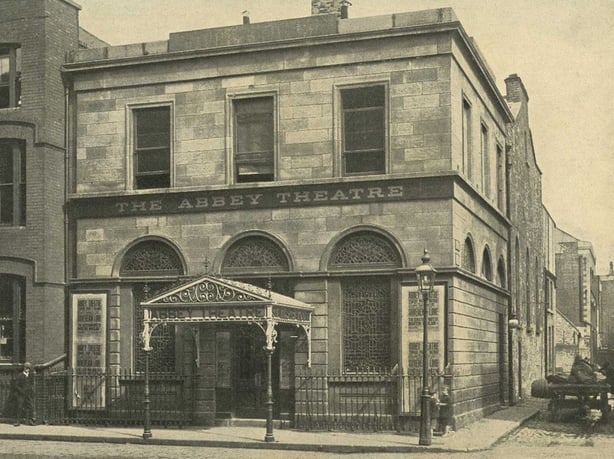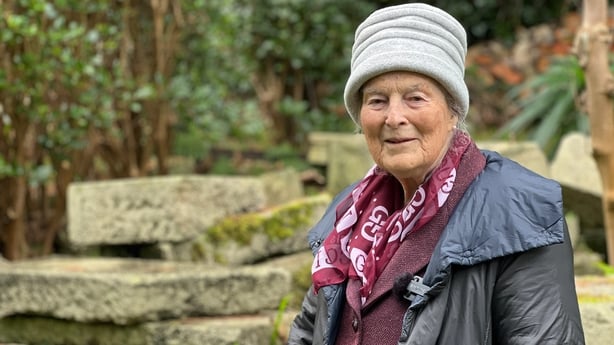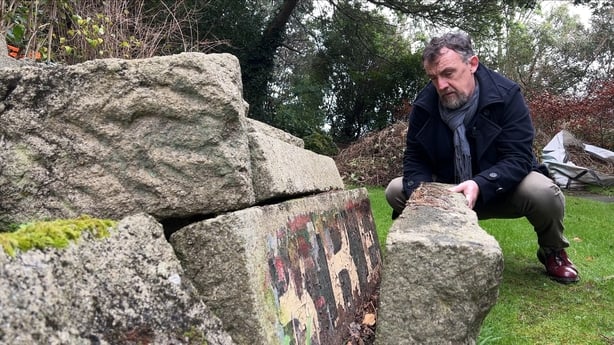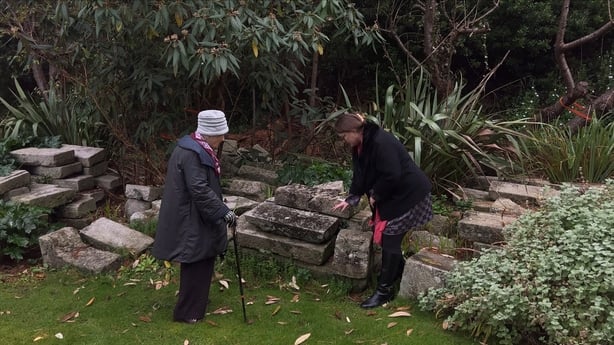A 93-year-old woman says it will mean "everything" if her late husband's dream of restoring the building blocks of the original Abbey Theatre is finally realised.
In 1961, Dáithí Hanly, the Dublin city architect at the time, salvaged 720 granite blocks of the facade of the old theatre just as it was being demolished.
He was horrified that the remnants of the theatre of Yeats, Synge and O'Casey, which had been damaged by fire ten years earlier, were about to be dumped.

Mr Hanly arranged for the stones to be brought to his home in Dalkey, where they have been kept in the garden ever since.
"He saw the building being demolished, with the stones being removed from the top, down to the the threshold," Mr Hanly's wife, Joan, explains. "And my husband said 'no, that building meant so much to the nation, influencing people to be free'.
"We were just back from our honeymoon and moving into our home. The contractors who were demolishing the Abbey were the ones we were using here. He arranged for the blocks to all be numbered, so we knew how to put them together again, and they were brought here by lorry.
"It was just convenient to dump them in the garden at the time. I just said 'yes, of course', thinking I wouldn't have to do any gardening in this section!'"

For several decades, Dáithí Hanly clung to the idea of using the blocks in a new theatre or as the entrance to a national theatre museum.
However, those projects never got off the ground and over time, the Hanly's garden took shape around them.
Today, piles of blocks interspersed by plants and shrubs line a long, narrow lawn overlooking Killiney Bay.
On one of the blocks, you can still make out the original painted lettering from the sign above the theatre's entrance.

"It's incredible to see this. The B, B, E from the sign above the Abbey Theatre as it was," says the Abbey's Executive Director Mark O'Brien.
"The vision of Dáithí Hanly to bring the stones to his back garden and save them to be a resource into the future was amazing and very moving actually. To have them still available to us a nation is really special."
Mr O'Brien took the opportunity to see the stones as the Office of Public Works (OPW) begins an ambitious plan to conserve them.
"Stone conservation is our bread and butter so I think we are ideally placed to look after the stones," explains Terri Sweeney Meade, Assistant Principal Architect at the OPW.
"We are going to remove them in the way they were delivered. These were all brought here very carefully. They didn't crack and they are very intact. One of the critical things Mr Hanly did was numbering the stones. The numbers are still on them, written in chalk. So now we have a complete jigsaw puzzle."

Following their conservation, it's hoped the blocks can be used in the redevelopment of the current Abbey Theatre.
"We're in the process of a business case that's going through Government of building a new national theatre. That these stones will be a resource in that process is just extraordinary, both for the theatre and the State," explains Mr O'Brien.
As the well as the stones, Dáithí Hanly also salvaged signage and posters from inside the theatre, which he kept in a garden shed.
"The day I got the phone call about the Abbey stones, I felt like my whole world shifted because I could see that this was going to be so extraordinary for everybody," says Ms Sweeney Meade.
"These two people, Joan and Dáithí, have given us back something that we had lost. And that is the most wonderful gift that you could possibly imagine.
"Mrs Hanly really has been a true heroine of the State because once he passed away in 2003, she remained determined to see his wishes fulfilled, that one day these stones would be reinstated on the corner of Marlborough Street and Abbey Street."
The delicate process of removing the stones from the Hanly's back garden and transporting them to the OPW's depot in the Phoenix Park is now under way.
Once there, they will be carefully cleaned and catalogued.
After more than six decades, Dáithí Hanly's dream looks like it could finally become reality - and Joan Hanly hopes no stone will be left unturned.
"That would mean everything to him."

